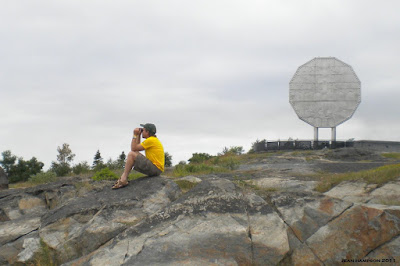
Last year, Jean and I found only a few of the invasive pests in our garden. This year however, the numbers have increased greatly and they have acquired a taste for the leaves of a Corkscrew Hazel tree in the backyard. At first, I tried to pick them off of the tree but for every 1-2 I removed, another 8-10 would emerge from the inner branches and leaves to escape placement into an empty yogourt tub. Knowing I could not win this battle, I took the garden hose and sprayed the entire tree with a good dose of H2O. With travel plans the next day, my options were limited and spraying the tree would help temporarily.
A grape vine that has crept over the fence from the neighbour's yard was also harbouring some Japanese Beetles. When searching for additional Popillia japonica, I came across this large orange beetle. It appears to be from the Scarabaeidae family, the same family that contains the Japanese Beetle and the Asiatic Garden Beetle. After a little searching, I identified this large insect to be a Grapevine Beetle.

A few years ago, this beetle caused heavy damage to my mother-in-law's ornamental grapevine. So, I quickly disposed of this specimen as well.
The next day, Jean and I left for Sudbury. Taking action to prevent further damage would have to wait. I had some Big Nickel birding to do.
















